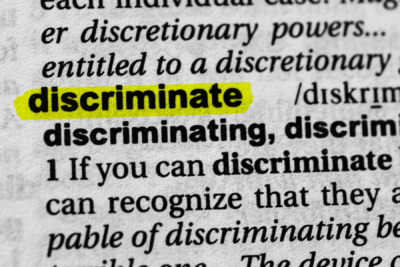Despite significant legal progress over the last half-century, gender discrimination in the workplace continues to affect employees in nearly every industry. From corporate offices and hospitals to schools and public agencies, workers still face unequal pay, bias in promotions, and exclusion from opportunities, not always in ways that are easy to spot. For many employees, discrimination begins subtly: being passed over for leadership roles, dismissed in meetings, or unfairly disciplined compared to peers. Over time, these patterns take a toll on confidence, career growth, and financial security.
Understanding examples of gender discrimination in the workplace is the first step toward protecting your rights. By learning how bias appears both overtly and subtly, employees can recognize when treatment crosses the legal line and when to take action. While every workplace is different, federal laws set clear standards for equality and prohibit any adverse employment decisions based on gender, identity, or sexual orientation.
This guide outlines common forms of workplace gender discrimination, key federal protections under Title VII, and steps employees can take when facing bias, and when to contact an employment discrimination attorney.

Understanding Gender Discrimination in the Workplace
Gender discrimination at work happens when someone is treated unfairly because of sex, gender identity, or sexual orientation. The EEOC states this violates Title VII of the Civil Rights Act, which bans employment decisions based on gender, stereotypes, pregnancy, or related conditions.
While some forms of bias are obvious, others are more subtle. Workplace gender discrimination can appear in hiring, pay, promotion, training, or disciplinary practices, often masked by “neutral” policies that disproportionately harm one gender.
Common Examples of Gender Discrimination in the Workplace
Although every situation is different, some patterns are common in all industries. Here are the most frequent examples of workplace gender discrimination:
- Unequal Pay for Equal Work
Pay disparity is a clear sign of gender discrimination. Employees doing similar work should get equal pay. When women or gender-diverse staff earn less than men for the same role, it may violate Title VII and the Equal Pay Act.
2. Biased Hiring and Promotion Decisions
A common issue is employers favoring one gender in hiring or promotion. This includes rejecting candidates based on stereotypes. The NWLC reports women are often passed over for certain roles due to bias, not qualifications.
3. Exclusion from Leadership or Networking Opportunities
The AAUW notes that women and gender minorities are often kept out of key networks, mentoring, and executive tracks. Denying access to these career paths due to gender keeps inequality in place and breaks anti-discrimination laws.
4. Discriminatory Discipline and Evaluations
Gender discrimination also appears in reviews and discipline. Women may be called “emotional” for behavior described as “assertive” in men. Uneven feedback or discipline can violate federal law.
5. Pregnancy and Caregiver Discrimination
The EEOC views pregnancy-related discrimination as gender discrimination in the workplace. Examples include denying accommodations, refusing to hire pregnant applicants, or sidelining employees after maternity leave. Caregiver bias can affect any employee taking parental or family leave, both of which are protected under Title VII and the Pregnancy Discrimination Act.
Legal Protections Against Workplace Gender Discrimination
Federal law strongly protects employees from gender bias. Title VII help to handle workplace discrimination by banning discrimination based on sex, gender identity, and sexual orientation. Employers cannot base decisions or create unfair work environments because of these traits.
Additional laws strengthen these protections:
- Equal Pay Act of 1963: Requires equal wages for men and women performing substantially equal work.
- Pregnancy Discrimination Act: Prohibits discrimination based on pregnancy, childbirth, or related medical conditions.
- EEOC Enforcement: The EEOC investigates and resolves complaints, helping employees pursue justice when rights are violated.
These statutes ensure all employees receive fair and equal treatment.
What to Do if You Experience Gender Discrimination
Navigating Discrimination in the workplace may or may not be obvious. If you believe you’ve faced gender discrimination, act promptly and stay organized. These steps help protect your rights:
- Document incidents carefully. Keep records of discriminatory comments, pay disparities, or inconsistent discipline.
- Review your company’s policies. Most employers have written procedures for reporting discrimination internally.
- Report to HR or a supervisor. Provide clear, factual accounts of what occurred and when.
- File a complaint with the EEOC. Federal law typically requires you to file within 180 days of the last discriminatory act.
- Seek legal guidance. An experienced employment law attorney can help you evaluate your case, gather evidence, and represent you through the EEOC process or litigation if necessary.
These steps can prevent retaliation and ensure your complaint gets proper attention under federal law.
Recognizing Subtle Forms of Gender Bias
While overt discrimination is clear, workplace bias is often subtle. Examples such as unequal access to development opportunities.
- Gendered expectations in dress codes or appearance.
- Excluding certain employees from high-visibility projects.
- Penalizing workers for taking family or medical leave.
Spotting subtle bias is key to building a fair, inclusive workplace.
How Cantrell Schuette Helps Employees Nationwide
Gender discrimination in the workplace causes more than financial harm; it damages confidence, hinders advancement, and affects emotional well-being. Cantrell Schuette’s gender discrimination attorneys help clients understand their rights, gather documentation, and seek fair resolutions through negotiation or litigation nationwide.
Our firm’s national experience allows us to identify patterns of bias and develop strong legal strategies that hold employers accountable. Whether your case involves unequal pay, promotion denials, retaliation, or systemic bias, our team of attorneys bring clarity and confidence to what can be an otherwise difficult process.
Protecting Your Right to Fair Treatment
Every employee deserves a workplace where skill, effort, and performance, not gender, determine opportunity. Yet gender discrimination in the workplace continues to erode trust and limit advancement for millions of workers. Understanding your rights and the laws that protect you is the foundation for change, both individually and systemically. Awareness allows employees to name injustice when it occurs, document it clearly, and take action under the law.
These examples of gender discrimination in the workplace, from pay inequities to biased evaluations, are reminders that equality requires both vigilance and accountability. Federal protections like Title VII exist to ensure that every worker, regardless of gender identity or expression, has an equal opportunity to succeed.
If you face workplace gender discrimination, you can speak up and seek justice. Contact us today. We support employees nationwide, offering compassionate guidance and advocacy to help protect your rights, career, and dignity.



